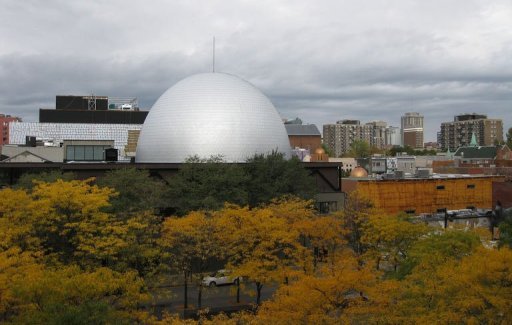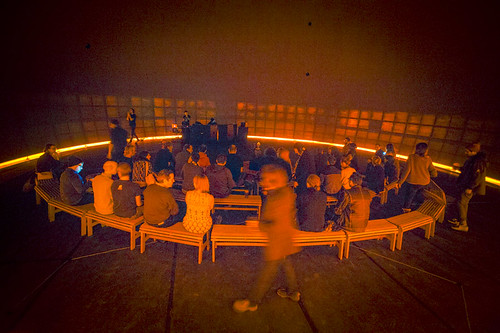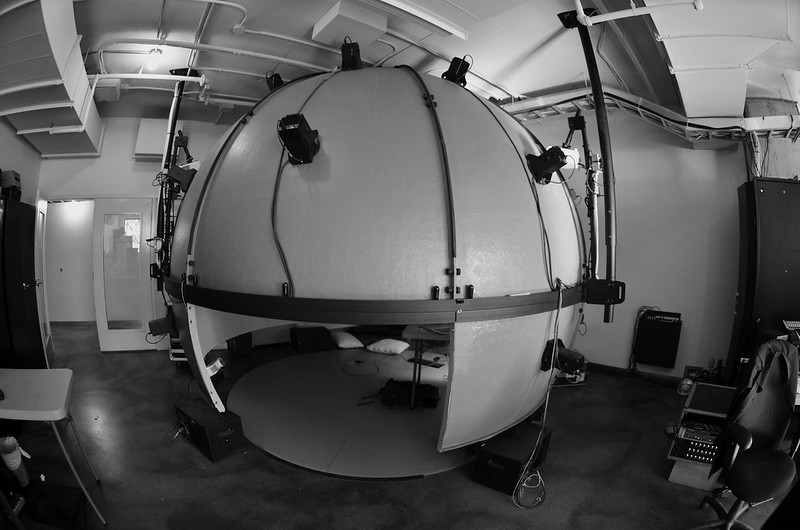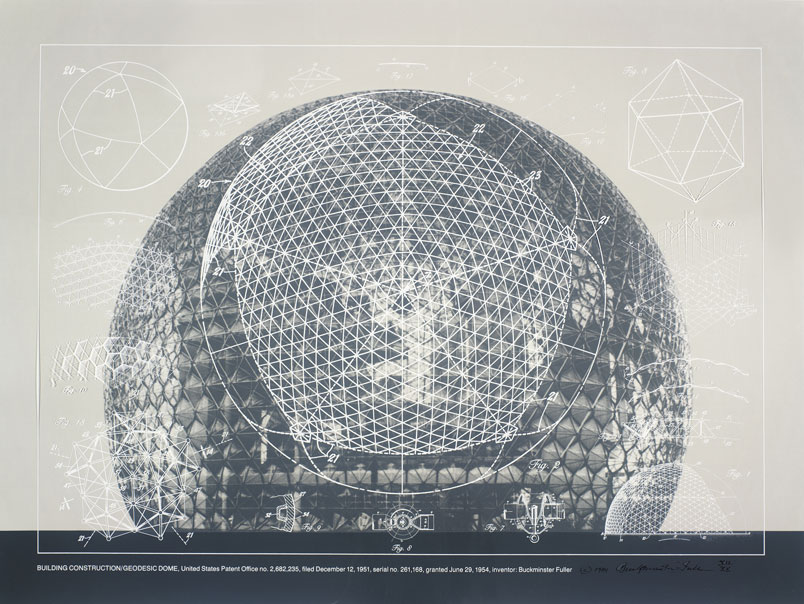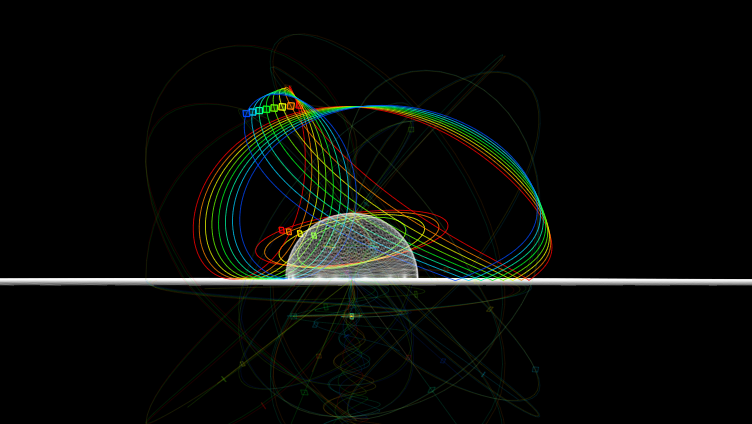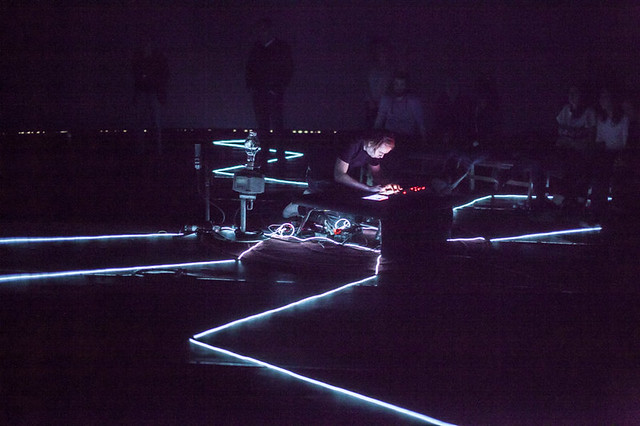Prélude
« On peut dire qu'à l’avenir, la musique deviendra spatiale. Je crois que le mouvement des sons dans l'espace sera aussi important que la mélodie, l'harmonie, le rythme, la dynamique, le timbre ».
Plus tard, en 1970, accompagné de l'architecte Fritz Bornemann, Stockhausen conçoit un auditorium sphérique de 28 mètres de diamètre pour le planétarium du pavillon allemand de l'exposition universelle d'Osaka. Il y voit une architecture idéale de spatialisation du son.
Ce faisant il crée un lien entre architecture, spatialisation et composition, qui sera plus tard approfondi par l'oeuvre de Xenakis. Le travail de ces précurseurs est aujourd'hui au coeur d'un courant de création contemporaine s'intéressant à la relation espace/son ainsi ouvrant un champ de possibilités d'interaction avec les arts visuels.
Un mot sur la Satosphère
La Satosphère de la Société des Arts Technologiques à Montreal, est un espace immersif, un dôme hémisphérique de 18 mètres de diamètre et de 13 mètres de hauteur.
Photo #1 - Satosphère - SAT Montreal
Formé d'un écran de projection de 360 degrés et supportant un dispositif sonore fait de 157 haut parleurs, la Satosphère est un espace hors norme dédiée à la création artistique utilisant l'immersion (visuel et/ou sonore) comme axe d'expression principal. Elle peut accueillir jusqu'à 350 spectateurs.
Photo #2 - Interieur Satosphère - Par Sébastien Roy
Photo #3 - LaboDome - Société Des Arts Technologiques (SAT)
Immersion Sonore
ENTROPIA
Photo #4 - Boris Artzybasheff (1899-1965) R. Buckminster Fuller, 1963, gift of Time magazine.Photo #5 Buckminster Fuller, Collection SFMOMA, gift of Chuck and Elizabeth Byrne; © The Estate of R. Buckminster Fuller, All Rights reserved; image courtesy SFMOMA
Approche concetpuelle
En thermodynamique, alors que le premier principe est un principe de conservation de l’énergie, le second est un principe d’évolution. Il stipule que toute transformation réelle s’effectue avec augmentation inéluctable du désordre global ; le désordre étant mesuré par l’entropie. On dit encore qu’il y a création d’entropie. Ici comme dans Dromos, Fraction met la création immersive au service d’un questionnement scientifique afin de mieux rendre visible un phénomène qui échappe à notre observation objective, tant il nous dépasse par son échelle.
Pour Richard B. Fuller, le dôme géodésique était la réponse de l’architecte à des interrogations fondées sur notre devoir de mettre en oeuvre un développent soutenable dans un monde fini qui tendrait vers le désordre. En jouant sur le symbole de ce dôme, l’artiste propose une réponse esthétique à contre-pied en traitant la notion de désordre sonore et en donnant l’occasion aux spectateurs de se saisir de ces questions par l’intermédiaire d’une expérience multi-modale.
ARCHITECTURE SONORE
Entropia est une performance de musique électronique sonore multi-canal dans laquelle le compositeur joue avec la spatialisation, les mouvements et des effets qui s'appliquent sur tout le champ spatial afin de récréer des contrastes évoquant esthétiquement le chaos. Au coeur de l'oeuvre, le SPAT de l'Ircam opère comme un point de passage pour tous les signaux audio, déclenchés et traités en temps réel. L'ambisonie d'ordre 4 est atteinte à travers la diffusion de 8 à 16 sources sonores dans 31 voies, (les 157 haut-parleurs de la Satosphère étant regroupés en clusters). Il se crée donc un plasma sonore dense, que l'artiste peut figer, ainsi que des contrastes spatiaux se jouant des limites physiques du dôme.
L'oeuvre sonore repose sur 4 fondamentaux interconnectés :
1- Ambisonics 3D, avec l'utilisation du Spat orchestrant la diffusion de la matière sonore
2- Conceptualisation architecturale, à travers l'utilisation de Iannix pour le design des mouvements spatiaux
3- Ecriture musicale abstraite, jouant sur la synthèse atonale
4- Contrôle en temps réel pendant le concert de la spatialisation, des traitements, et du mix par l'utilisation de surfaces tactiles (Ipads)
SPAT: Ambisonie 3D
Avec son architecture hémisphérique et ses 31 canaux de diffusion possible lui faisant corps, la Satosphère est propice pour la création et la diffusion d'un champ sonore ambisonic 3D. Le Spat convertit les sources sonores, ici par Live Ableton, et un synthétiseur Nord. L'artiste à ce stade peut positionner manuellement les sources dans l'espace 3D ainsi que contrôler tous les paramètres acoustiques du Spat, en utilisant une interface tactile spécialement développée pour le projet dans Liine Lemur.
Photo# 6 - Interface de contrôle temps réel pour la spatialisation dans SPAT - (Lemur Liine)
Iannix : Partition Spatiale
La recherche de mouvement et de densité est au coeur du propos d'Entropia. Il fallait donc penser un dispositif particulier pour orchestrer la spatialisation. Iannix s'est imposé comme outil interactif pour contrôler et faire évoluer ces mouvements. Le logiciel, en abordant la création par la géometrie, permet également de faire un lien entre la dimension sonore 3D de l'oeuvre, et la dimension spatiale, au sens architectural.
Photos #7 - Rendu amélioré de partition iannix pour Entropia
L'oeuvre a été structurée en 5 tableaux esthétiques, chacun avec sa propre partition spatiale Iannix. Ces partitions conçues en collaboration avec Guillaume Jacquemin (équipe Iannix), sont constituées par des ensembles de courbes paramétriques, une pour chaque source, offrant un design cohérent en lien avec l'architecture du dome. Ces courbes déterminent les trajectoires des sources dans l'espace sonore 3D, tout en dessinant des formes qui participent à la narration de l'oeuvre.
Photo #8 - Rendus non améliorés de partition iannix pour Entropia
Les coordonnées des sources x,y,z sont envoyés dans par Max/msp - Spat qui reconstitue les mouvements, dans le contexte ambisonic. Le compositeur contrôle la vitesse de déplacement des sources sur les trajectoires, et peut transformer les courbes en direct, ainsi que moduler leur transformation automatiquement, ce qui conduit inéluctablement à accentuer la finalité stochastique de l'oeuvre, y compris donc dans sa spatialisation. Tous ces paramètres sont également contrôlés et pondérés en utilisant l'interface de contrôle.
https://vimeo.com/119534060
Les différents outils (lemur, iannix, spat/max-msp) sont connectés entre eux via OSC.
Esthétique du désordre
Le travail autour de l'esthétique du chaos est permanent dans Entropia. A travers un travail sur les masses sonores, la spatialisation et le traitement en temps réel, le compositeur immerge l'audience dans une expérience intense. L'univers sonore d'Entropia est composé de couches inharmoniques et de textures abstraites, essentiellement synthétiques, décrivant un ensemble d'une densité rude, pouvant s'affirmer brutalement dans certaines parties climaciques de l'oeuvre. Les mouvements spatiaux accompagnent l'enchevêtrement de timbres électroniques fortement traités dans un ballet sonore complexe, avant de fondre par instant dans des sursauts spectraux. L'esthétique de l'oeuvre est la résultante croisée de la composition studio et de la performance en temps réel de la spatialisation (spat) et des traitements qui s'appliquent sur le champ spatial 3D (delay, reverb, grain etc.).
Performance immersive & Temps réel
Le 16 décembre, au terme d'une résidence axée sur le développement conceptuel de l'oeuvre, Fraction a présenté à la SAT une première étape de la création. Au centre du dispositif immersif le compositeur utilise deux Ipads pour contrôler l'intégralité du système. Ils lui permettent d'une part de mixer la matière sonore, et d'autre part de la traiter, de la spatialiser et d'en contrôler les aspects acoustiques, en temps réel.
Photo #9 - Entropia - Resitution de résidence - Par Sébastien Roy
En devenant immersif, la performance électronique change de nature, change le rapport du compositeur au spectateur, et celui du spectateur au lieu dans lequel il se situe. Cela amène à repenser la scénographie pour accompagner une énergie sonore qui n'est plus confinée à une partie de l'espace mais englobe le lieu de performance. Là encore, le lien entre architecture, lumière et son est omniprésent et pose de nouveaux questionnements esthétiques. L'oeuvre finale comportera un aspect visuel qui donnera la dimension physique à l'oeuvre, et renforcera le sentiment immersif pour le spectateur. Dans cette optique, une ébauche de scénographie réalisée par Louis-Philippe St-Arnault, a été mise en place lors du concert de restitution. Elle donne un léger aperçu de ce que sera la version d'Entropia qui sera finalisée en 2015 pour sa diffusion public.
Pour aller plus loin
Interview de l'artiste sur le site de la SAT
*: Présenté dans le cadre d’un programme d’échanges France-Québec entre le Conseil des Arts et des Lettres du Québec (CALQ) et l’Institut Français. La réalisation de cette résidence est rendue possible grâce à la collaboration de l'Institut français, de la Gaîté lyrique, du Cube, de la Société des arts technologiques et de OBORO.

